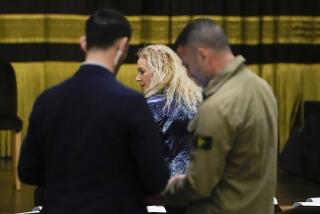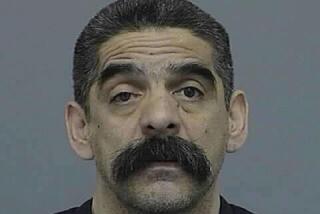Filming Insurrection on Location With a Band of Filipino Guerrillas
POTOMAC, MD. — Sauntering into the hotel bar, he wore a Lacoste tennis shirt, smoked Marlboros and, speaking American slang, introduced himself as “Buddy.” He might have been a young high school teacher or perhaps a real-estate salesman. But that night, whatever his true profession, he was acting as a communist agent. He arrived to fetch our television team for a visit to a rebel “zone” on the Philippine island of Negros.
Under his direction, we lugged a ton of equipment through the lobby as the desk staff and assorted loungers watched without a trace of curiosity. A van then drove us to a nearby sugar plantation set against a horizon of purple hills. A full moon silhouetted our figures as we trekked across the fields to a tiny barrio of five or six squalid huts hidden in a palm grove. I felt as if I had stepped into a movie location--and I was not entirely wrong.
Awaiting us was a squad of guerrillas straight out of Central Casting-- dressed in bluejeans and surplus U.S. Army fatigue jackets or counterfeit American university sweat shirts. A few sported baseball caps and some had wrapped their chests in cartridge belts. They brandished various weapons--Uzis manufactured in Israel, U.S.-made Armalite rifles and that revolutionary symbol, the Chinese AK-47. One, reaching into his pocket, fished out a collection of frayed calling cards bearing the names of correspondents--American, Australian, Japanese and others. “They’ve all been here,” he said proudly--confirming my suspicion that we were in for a media event.
In nearly 40 years of journalism, I have reported on insurgencies in Africa, the Middle East and Asia. Despite a common rhetoric borrowed from Marx and Mao, each rebel group reflected distinct national traits. Not once during more than a decade in Vietnam was I able to contact the Viet Cong, a grim bunch that suspected U.S. correspondents of being covert agents. I was fortunate in Cambodia to have avoided the Khmer Rouge, which systematically killed reporters just as it slaughtered millions of Cambodians. Filipino communists, by contrast, are first and foremost Filipinos--whose taste for show biz is encapsulated in a Tagalog term, palabas , literally the gaudy ostentation of a village fiesta.
This is not to suggest the uprising is a comedy. Throughout the islands, it has cost thousands of lives and caused years of suffering, mostly among innocent villagers caught in the cross-fire between government and guerrillas. Support for the rebels among impoverished peasants also dramatizes the unmet need for drastic social and economic reforms. But like so much else in the Philippines, where tragedy is often transformed into farce, insurgency sometimes seems surreal.
Philippine provinces have long sustained self-proclaimed religious messiahs, political dissidents and outlaws, many of whom attracted poor and oppressed peasants desperate to protest against their landlords. Communists and socialists similarly appealed to the aggrieved rural population when they organized the Hukbalahap insurrection during the 1950s. And the same dismal conditions offered an opportunity to founders of the current rebellion who split from the original Communist Party in early 1969. Their revolt is merely the latest in a series that has plagued the country for centuries. But while Filipino communists are serious, they are rarely solemn. Cheerful NPA operatives regularly appear at the homes of rich Manila matrons eager to display a touch of radical chic.
Keen to promote their mission at their sugar-plantation sanctuary on Negros, the guerrillas treated us to the kind of rote propaganda that has become obsolete among communists elsewhere--a symptom of their isolation.
But as we sipped beer and smoked my cigarettes, they clearly preferred mundane conversation to ideological claptrap. They dunned me with questions about the United States, where several had relatives. One, for example, wondered if I knew his uncle in Cleveland. When I asked which city in the world they would most like to visit, the consensus was San Francisco rather than Moscow, Beijing or Hanoi, once the Marxist Meccas.
Unabashed admirers of U.S. movies, they made their terrorist exploits sound like scenes from a Western. One man described the assassination of a reputedly cruel cop: “We followed him into a cafe, his regular hangout. The place cleared out immediately, and we shot him--point blank. He never knew what hit him.”
Another confided that he rallied to the communists because he had failed to fulfill his boyhood dream of being like a movie American. As he put it: “Americans were rich, handsome and superior. I degraded Filipinos because they were ugly, with flat noses and brown skins. But I was also ugly. I wasn’t a good student and could not speak English well. I started to hate America when I realized that I would never become like an American.”
Maybe Hollywood inspired the insurgents we filmed. They were talented performers, familiar with television techniques, as we recorded a cadre of them on a training exercise. Grim expressions on their faces, they filed along a jungle trail, halting from time to time, guns cocked for action, scanning the potentially dangerous landscape. As they finally reached a point beyond camera range, their chief stopped, turned and said: “Let’s do a retake.”
Late one afternoon, two regional communist commanders swept into the barrio in a Jeep. One, Francisco Fernandez, was a sinewy man in his 30s who turned out to be a priest; villagers addressed him as “Father Frank.” Facing the camera, a pistol tucked into his belt, he squared his religious faith with violance in a predictable sermon: “My conscience is clear. Our cause is just.” The other man, Nemasio Demafelis, was a burly former political-science major at a local college; he joined the communists during the student ferment of the 1970s and later rose to the rank of party boss on the island of Negros. He supported Fernandez’s plea for tough tactics but sang a different refrain when we met again under other circumstances.
Months later, on a visit to Bacolod, the capital of Negros Occidental, I happened upon the province police chief who remarked that he had Demafelis behind bars. “May we interview him?” I promptly asked. He promptly answered: “Why not?”
The chief, in a typical display of Filipino hospitality, welcomed us next morning at his dingy prison. Demafelis was there, smiling warmly, agreeing to a filmed interview. He had defected, he explained, because he refused to accept the strategy of “indiscriminate killing” championed by Fernandez and other comrades--including his own wife, an insurgent leader. Since then, protected by guards, he has taken to farming.
Demafelis’ defection damaged the communist movement on Negros, causing other opponents of all-out violence to quit as well. Meanwhile, the insurgency has been set back by other blunders. In Manila not long ago, the police broke into a clandestine communist headquarters to find computer discs containing membership rosters, financial data and other details. High-tech had backfired.
Yet communists will persist as long as the islands are plagued by appalling social and economic inequities. NPA sloppiness suggests that their chances of victory are slim, at least within the foreseeable future. While the army is strong enough to prevent the rebels from winning, it is too ineptly led, equipped and motivated to prevail. Thus neither side seems able to break the deadlock and a benighted rural population is still paying a heavy price.


